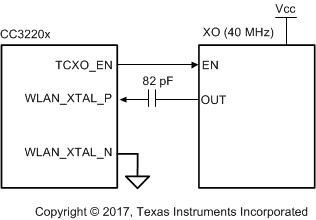SWAS035C September 2016 – May 2021 CC3220R , CC3220S , CC3220SF
PRODUCTION DATA
- 1 Features
- 2 Applications
- 3 Description
- 4 Functional Block Diagrams
- 5 Revision History
- 6 Device Comparison
- 7 Terminal Configuration and Functions
-
8 Specifications
- 8.1 Absolute Maximum Ratings
- 8.2 ESD Ratings
- 8.3 Power-On Hours (POH)
- 8.4 Recommended Operating Conditions
- 8.5 Current Consumption Summary (CC3220R, CC3220S)
- 8.6 Current Consumption Summary (CC3220SF)
- 8.7 TX Power and IBAT versus TX Power Level Settings
- 8.8 Brownout and Blackout Conditions
- 8.9 Electrical Characteristics (3.3 V, 25°C)
- 8.10 WLAN Receiver Characteristics
- 8.11 WLAN Transmitter Characteristics
- 8.12 WLAN Filter Requirements
- 8.13 Thermal Resistance Characteristics
- 8.14
Timing and Switching Characteristics
- 8.14.1 Power Supply Sequencing
- 8.14.2 Device Reset
- 8.14.3 Reset Timing
- 8.14.4 Wakeup From HIBERNATE Mode
- 8.14.5 Clock Specifications
- 8.14.6
Peripherals Timing
- 8.14.6.1 SPI
- 8.14.6.2 I2S
- 8.14.6.3 GPIOs
- 8.14.6.4 I2C
- 8.14.6.5 IEEE 1149.1 JTAG
- 8.14.6.6 ADC
- 8.14.6.7 Camera Parallel Port
- 8.14.6.8 UART
- 8.14.6.9 SD Host
- 8.14.6.10 Timers
- 9 Detailed Description
- 10Applications, Implementation, and Layout
- 11Device and Documentation Support
- 12Mechanical, Packaging, and Orderable Information
Package Options
Mechanical Data (Package|Pins)
- RGK|64
Thermal pad, mechanical data (Package|Pins)
- RGK|64
Orderable Information
8.14.5.4 Fast Clock (Fref) Using an External Oscillator
The CC3220x device can accept an external TCXO/XO for the 40-MHz clock. In this mode of operation, the clock is connected to WLAN_XTAL_P (pin 23). WLAN_XTAL_N (pin 22) is connected to GND. The external TCXO/XO can be enabled by TCXO_EN (pin 21) from the device to optimize the power consumption of the system.
If the TCXO does not have an enable input, an external LDO with an enable function can be used. Using the LDO improves noise on the TCXO power supply.
Figure 8-12 shows the connection.
 Figure 8-12 External TCXO Input
Figure 8-12 External TCXO Input
Section 8.14.5.4.1 lists the external Fref clock requirements.